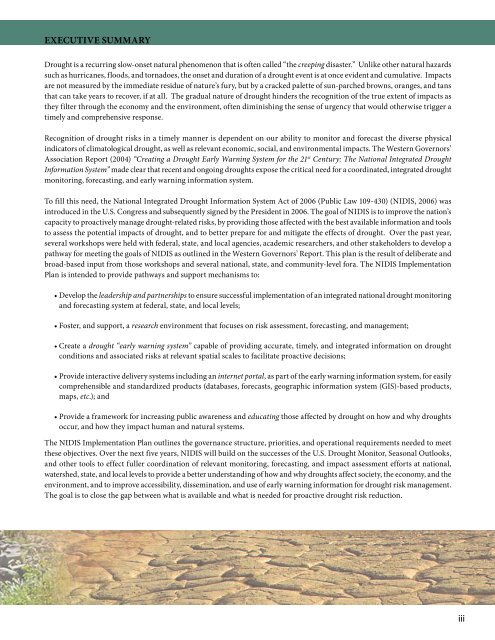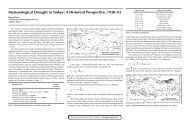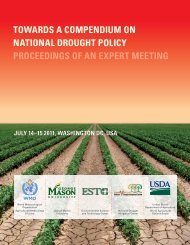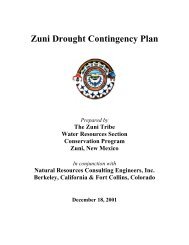Table of Contents - National Drought Mitigation Center - The ...
Table of Contents - National Drought Mitigation Center - The ...
Table of Contents - National Drought Mitigation Center - The ...
Create successful ePaper yourself
Turn your PDF publications into a flip-book with our unique Google optimized e-Paper software.
ExEcutivE SummaRy<br />
<strong>Drought</strong> is a recurring slow-onset natural phenomenon that is <strong>of</strong>ten called “the creeping disaster.” Unlike other natural hazards<br />
such as hurricanes, floods, and tornadoes, the onset and duration <strong>of</strong> a drought event is at once evident and cumulative. Impacts<br />
are not measured by the immediate residue <strong>of</strong> nature’s fury, but by a cracked palette <strong>of</strong> sun-parched browns, oranges, and tans<br />
that can take years to recover, if at all. <strong>The</strong> gradual nature <strong>of</strong> drought hinders the recognition <strong>of</strong> the true extent <strong>of</strong> impacts as<br />
they filter through the economy and the environment, <strong>of</strong>ten diminishing the sense <strong>of</strong> urgency that would otherwise trigger a<br />
timely and comprehensive response.<br />
Recognition <strong>of</strong> drought risks in a timely manner is dependent on our ability to monitor and forecast the diverse physical<br />
indicators <strong>of</strong> climatological drought, as well as relevant economic, social, and environmental impacts. <strong>The</strong> Western Governors’<br />
Association Report (2004) “Creating a <strong>Drought</strong> Early Warning System for the 21 st Century: <strong>The</strong> <strong>National</strong> Integrated <strong>Drought</strong><br />
Information System” made clear that recent and ongoing droughts expose the critical need for a coordinated, integrated drought<br />
monitoring, forecasting, and early warning information system.<br />
To fill this need, the <strong>National</strong> Integrated <strong>Drought</strong> Information System Act <strong>of</strong> 2006 (Public Law 109-430) (NIDIS, 2006) was<br />
introduced in the U.S. Congress and subsequently signed by the President in 2006. <strong>The</strong> goal <strong>of</strong> NIDIS is to improve the nation’s<br />
capacity to proactively manage drought-related risks, by providing those affected with the best available information and tools<br />
to assess the potential impacts <strong>of</strong> drought, and to better prepare for and mitigate the effects <strong>of</strong> drought. Over the past year,<br />
several workshops were held with federal, state, and local agencies, academic researchers, and other stakeholders to develop a<br />
pathway for meeting the goals <strong>of</strong> NIDIS as outlined in the Western Governors’ Report. This plan is the result <strong>of</strong> deliberate and<br />
broad-based input from those workshops and several national, state, and community-level fora. <strong>The</strong> NIDIS Implementation<br />
Plan is intended to provide pathways and support mechanisms to:<br />
• Develop the leadership and partnerships to ensure successful implementation <strong>of</strong> an integrated national drought monitoring<br />
and forecasting system at federal, state, and local levels;<br />
• Foster, and support, a research environment that focuses on risk assessment, forecasting, and management;<br />
• Create a drought “early warning system” capable <strong>of</strong> providing accurate, timely, and integrated information on drought<br />
conditions and associated risks at relevant spatial scales to facilitate proactive decisions;<br />
• Provide interactive delivery systems including an internet portal, as part <strong>of</strong> the early warning information system, for easily<br />
comprehensible and standardized products (databases, forecasts, geographic information system (GIS)-based products,<br />
maps, etc.); and<br />
• Provide a framework for increasing public awareness and educating those affected by drought on how and why droughts<br />
occur, and how they impact human and natural systems.<br />
<strong>The</strong> NIDIS Implementation Plan outlines the governance structure, priorities, and operational requirements needed to meet<br />
these objectives. Over the next five years, NIDIS will build on the successes <strong>of</strong> the U.S. <strong>Drought</strong> Monitor, Seasonal Outlooks,<br />
and other tools to effect fuller coordination <strong>of</strong> relevant monitoring, forecasting, and impact assessment efforts at national,<br />
watershed, state, and local levels to provide a better understanding <strong>of</strong> how and why droughts affect society, the economy, and the<br />
environment, and to improve accessibility, dissemination, and use <strong>of</strong> early warning information for drought risk management.<br />
<strong>The</strong> goal is to close the gap between what is available and what is needed for proactive drought risk reduction.<br />
iii








